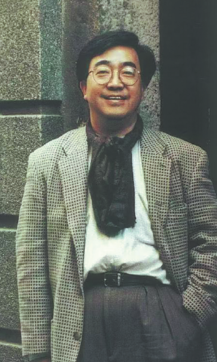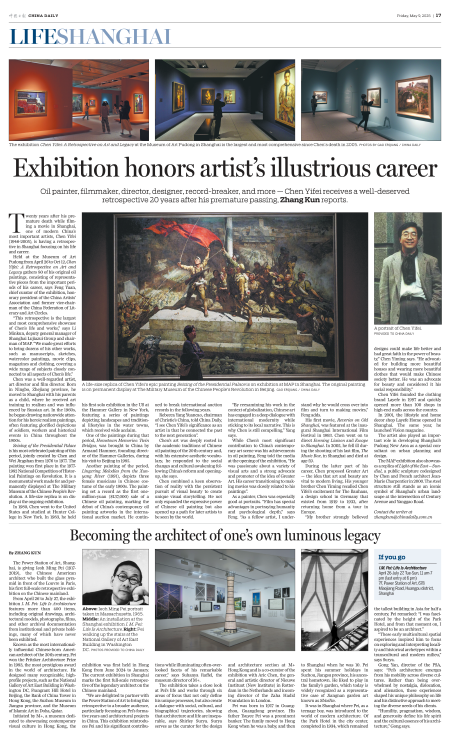
The exhibition Chen Yifei: A Retrospective on Art and Legacy at the Museum of Art Pudong in Shanghai is the largest and most comprehensive since Chen's death in 2005.

A life-size replica of Chen Yifei's epic painting Seizing of the Presidential Palace is on exhibition at MAP in Shanghai. The original painting is on permanent display at The Military Museum of the Chinese People's Revolution in Beijing.

A portrait of Chen Yifei.
Twenty years after his premature death while filming a movie in Shanghai, one of modern China's most important artists, Chen Yifei (1946-2005), is having a retrospective in Shanghai focusing on his life and career.
Held at the Museum of Art Pudong from April 26 to Oct 12, Chen Yifei: A Retrospective on Art and Legacy gathers 80 of his original oil paintings, consisting of representative pieces from the important periods of his career, says Feng Yuan, chief curator of the exhibition, honorary president of the China Artists' Association and former vice-chairman of the China Federation of Literary and Art Circles.
"This retrospective is the largest and most comprehensive showcase of Chen's life and works," says Li Minkun, deputy general manager of Shanghai Lujiazui Group and chairman of MAP. "We made great efforts to bring dozens of his other works, such as manuscripts, sketches, watercolor paintings, movie clips, magazines and clothing, covering a wide range of subjects closely connected to all aspects of Chen's life."
Chen was a well-regarded artist, art director and film director. Born in Ningbo, Zhejiang province, he moved to Shanghai with his parents as a child, where he received art training in realism and was influenced by Russian art. In the 1960s, he began drawing nationwide attention for his heroic realism paintings, often featuring glorified depictions of soldiers, workers and historical events in China throughout the 1900s.
Seizing of the Presidential Palace is his most celebrated painting of this period, jointly created by Chen and Wei Jingshan from 1976 to 1977. The painting won first place in the 1977-1982 National Competition of Historical Paintings on Revolution. It is a monumental work made for and permanently displayed at The Military Museum of the Chinese People's Revolution. A life-size replica is on display at the ongoing exhibition.
In 1980, Chen went to the United States and studied at Hunter College in New York. In 1983, he held his first solo exhibition in the US at the Hammer Gallery in New York, featuring a series of paintings depicting landscapes and traditional lifestyles in the water towns, which received wide acclaim.
One of the paintings during that period, Hometown Memories: Twin Bridges, was brought to China by Armand Hammer, founding director of the Hammer Galleries, during his visit to Beijing in 1985.
Another painting of the period, Lingering Melodies from the Xunyang River (1991), depicts three female musicians in Chinese costume of the early 1900s. The painting set a record as the first one-million-yuan ($137,000) sale of a Chinese oil painting, marking the debut of China's contemporary oil painting artworks in the international auction market. He continued to break international auction records in the following years.
Rebecca Yang Yuancao, chairman of Christie's China, told China Daily, "I see Chen Yifei's significance as an artist in that he connected the past to the next generation".
Chen's art was deeply rooted in the academic traditions of Chinese oil painting of the 20th century and, with his extensive aesthetic vocabulary, he responded to the social changes and cultural awakening following China's reform and opening-up, she says.
Chen combined a keen observation of reality with the persistent pursuit of visual beauty to create unique visual storytelling. He not only expanded the expressive power of Chinese oil painting but also opened up a path for later artists to be seen by the world.
"By reexamining his work in the context of globalization, Chinese art has engaged in a deep dialogue with international modernity while sticking to its local narrative. This is why Chen is still compelling," Yang says.
While Chen's most significant contribution to China's contemporary art scene was his achievements in oil painting, Feng told the media at the opening of the exhibition, "He was passionate about a variety of visual arts and a strong advocate and promoter of the idea of Greater Art. His career transitioning to making movies was closely related to his paintings".
As a painter, Chen was especially good at portraits. "Film has special advantages in portraying humanity and psychological depth," says Feng. "As a fellow artist, I understand why he would cross over into film and turn to making movies," Feng adds.
His first movie, Reveries on Old Shanghai, was featured at the inaugural Shanghai International Film Festival in 1993. Chen went on to direct Evening Liaison and Escape to Shanghai. In 2005, he fell ill during the shooting of his last film, The Music Box, in Shanghai and died at age 59.
During the latter part of his career, Chen proposed Greater Art — the idea that art and beauty are vital to modern living. His younger brother Chen Yiming recalled Chen Yifei's excitement for The Bauhaus, a design school in Germany that existed from 1919 to 1933, after returning home from a tour in Europe.
"My brother strongly believed designs could make life better and had great faith in the power of beauty," Chen Yiming says. "He advocated for building more beautiful houses and wearing more beautiful clothes that would make Chinese society better. He was an advocate for beauty and considered it his social responsibility."
Chen Yifei founded the clothing brand Layefe in 1997 and quickly opened more than 100 shops in high-end malls across the country.
In 2001, the lifestyle and home decor shop Layefe Home opened in Shanghai. The same year, he launched Vision magazine.
The artist also played an important role in developing Shanghai's Pudong New Area as a special consultant on urban planning and design.
The MAP exhibition also showcases a replica of Light of the East — Sundial, a public sculpture codesigned by Chen and French architect Jean-Marie Charpentier in 2000. The steel structure still stands as an iconic symbol of Shanghai's urban landscape at the intersection of Century Avenue and Yanggao Road.
Contact the writer at zhangkun@chinadaily.com.cn

